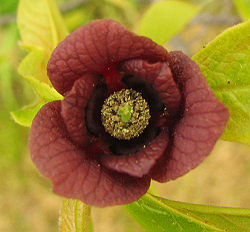Asimina triloba (pawpaw tree) 2 (27705591799)
Asimina triloba (Linnaeus, 1753) - pawpaw tree (Dawes Arboretum, Licking County, Ohio, USA)
Plants are multicellular, photosynthesizing eucaryotes. Most species occupy terrestrial environments, but they also occur in freshwater and saltwater aquatic environments. The oldest known land plants in the fossil record are Ordovician to Silurian. Land plant body fossils are known in Silurian sedimentary rocks - they are small and simple plants (e.g., Cooksonia). Fossil root traces in paleosol horizons are known in the Ordovician. During the Devonian, the first trees and forests appeared. Earth's initial forestation event occurred during the Middle to Late Paleozoic. Earth's continents have been partly to mostly covered with forests ever since the Late Devonian. Occasional mass extinction events temporarily removed much of Earth's plant ecosystems - this occurred at the Permian-Triassic boundary (251 million years ago) and the Cretaceous-Tertiary boundary (65 million years ago).
The most conspicuous group of living plants is the angiosperms, the flowering plants. They first unambiguously appeared in the fossil record during the Cretaceous. They quickly dominated Earth's terrestrial ecosystems, and have dominated ever since. This domination was due to the evolutionary success of flowers, which are structures that greatly aid angiosperm reproduction.
The pawpaw tree is native to much of eastern America, including the Central and Southern Appalachians, the Ohio Valley area, the Mississippi River Valley area, and the lower Missouri Valley area. The large fruit of this tree are edible for humans.
Classification: Plantae, Angiospermophyta, Magnoliales, Annonaceae
More info. at:
<a href="https://en.wikipedia.org/wiki/Asimina_triloba" rel="nofollow">en.wikipedia.org/wiki/Asimina_triloba</a>Relevante Bilder
Relevante Artikel
Dreilappige PapauDie Dreilappige Papau, mit wissenschaftlicher Bezeichnung Asimina triloba (L) Dunal, wird auch Indianerbanane oder Pawpaw genannt. Sie ist eine in Nordamerika heimische Pflanzenart aus der Gattung der Papau (Asimina) in der Familie der Annonengewächse (Annonaceae). Die Bezeichnung „Pawpaw“ kommt von Papaya und rührt von der Ähnlichkeit der Früchte her. Dieser Umstand führt immer wieder zu Verwirrungen, da in einigen Englisch sprechenden Ländern die Papaya ebenfalls Pawpaw genannt wird. „Indianerbanane“ wird sie unter anderem deshalb genannt, weil die Ureinwohner Nordamerikas, die Indianer, sie bereits kultivierten. Die Früchte sind essbar, sie gelten aber auch in ihrem Heimatland noch immer eher als Wildobst oder rare fruit. .. weiterlesen










